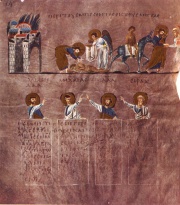Purple parchment
From Textus Receptus
Nick (Talk | contribs)
(New page: Page from the [[Rossano Gospels]] '''Purple parchment''' or '''Codex Purpureus''' refers to manuscripts written on parchment dy...)
Next diff →
Revision as of 02:06, 22 December 2011

Purple parchment or Codex Purpureus refers to manuscripts written on parchment dyed purple, originally restricted for the use of Roman or Byzantine Emperors. The lettering may be in gold or silver. Later the practice was revived for some especially grand illuminated manuscripts produced for the Emperors in Carolingian art and Ottonian art, in Anglo-Saxon England and elsewhere. Some just use purple parchment for sections of the work; the 8th century Anglo-Saxon Stockholm Codex Aureus alternates dyed and un-dyed pages.
The Purple Uncials or the Purple Codices is a well known group of these manuscripts, all 6th century New Testament Greek manuscripts:
- Codex Purpureus Petropolitanus N (022)
- Sinope Gospels O (023) (illuminated)
- Rossano Gospels Σ (042) (illuminated)
- Codex Beratinus Φ (043) (illuminated)
- Uncial 080
There are two other purple New Testament Greek manuscripts, classified as minuscules:
- Minuscule 565 known as the Empress Theodora's Codex
- Minuscule 1143 known as Beratinus 2
There is a 9th century lectionary:
- Codex Neapolitanus, former Codex Vindobonensis 2
Another six purple parchments (a, b, e, f, i, j), also New Testament manuscripts, are in Latin and held at: Brescia, Naples, Sarezzano and Trent. Three of these use Vetus Latina texts.
- Codex Vercellensis
- Codex Veronensis
- Codex Palatinus
- Codex Brixianus
- Codex Purpureus Sarzanensis
- Codex Vindobonensis Lat. 1235
There is also one Gothic purple codex — Codex Argenteus (illuminated)
There is a purple manuscript of part of the Septuagint:
- Vienna Genesis (illuminated)
Other illuminated manuscripts include the Godescalc Evangelistary of 781-3, the Vienna Coronation Gospels (early 9th century) and a few pages of the 9th century La Cava Bible from the Kingdom of Asturias. Anglo-Saxon examples include a lost 7th century gospels commissioned by Saint Wilfrid.
